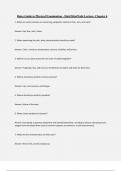Bates Guide to Physical Examination - Hair/Skin/Nails Lecture, Chapter 6
1. What are some common or concerning symptoms related to hair, skin, and nails?
Answer: Hair loss, rash, moles
2. When examining the skin, what characteristics should you note?
Answer: Color, moisture, temperature, texture, mobility, and lesions
3. Where can you best assess the red color of oxyhemoglobin?
Answer: Fingertips, lips, and mucous membranes (or palms and soles for dark skin)
4. Where should you look for central cyanosis?
Answer: Lips, oral mucosa, and tongue
5. Where should you look for jaundice?
Answer: Sclera of the eyes
6. What causes peripheral cyanosis?
Answer: Decreased cutaneous blood flow and slowed blood flow, resulting in tissues extracting more
oxygen from the blood than usual (a normal response to anxiety or a cold environment)
7. What are the characteristics of vellus hair?
Answer: Short, fine, and inconspicuous
,8. What are the characteristics of terminal hair?
Answer: Coarser, thicker, more conspicuous, usually pigmented (found on scalp, eyebrows)
9. What are the two types of sweat glands?
Answer: Eccrine (regulate body temperature) and apocrine (found in axillary and genital regions)
10. What are some causes of itching without a rash?
Answer: Dry skin, pregnancy, uremia, jaundice, lymphoma or leukemia, drug reaction, lice infestation,
diabetes or thyroid disease
* When examining the skin, what characteristics should you note?
+ Answer: Color, moisture, temperature, texture, mobility, and lesions
* What are some common or concerning symptoms related to hair, skin, and nails?
+ Answer: Hair loss, rash, moles
* Where can you best assess the red color of oxyhemoglobin?
+ Answer: Fingertips, lips, and mucous membranes (or palms and soles for dark skin)
Pallor ✔️Results from decreased redness in anemia and decreased blood flow (fainting or arterial
occlusion)
Causes of central cyanosis ✔️advanced lung disease, congenital heart disease, hemoglobinopathies
Cyanosis of heart failure is ✔️usually peripheral, reflecting deoxygenation or impaired circulation
COPD and pulmonary edema may give rise to central cyanosis
, Jaundice suggests ✔️liver disease or excessive hemolysis of red blood cells
Erythema ✔️Red skin hue due to increased blood flow
When testing mobility and turgor... mobility is... turgor is... ✔️Mobility - the ease with which the skin
lifts up
Turgor - the speed with which the lifted skin returns to place
Café-Au-Lait Spot
Slightly but uniformly pigmented macule or patch with a somewhat irregular border, benign ✔️Six or
more suggests neurofibromatosis
Tinea Versicolor
Common superficial fungal infection of the skin, causing hypo- or hyperpigmented (" versicolor"), slightly
scaly macules on the trunk, neck, and upper arms (short-sleeved shirt distribution). ✔️
Vitiligo
Depigmented macules appear on the face, hands, feet, extensor surfaces, and other regions and may
coalesce into extensive areas that lack melanin. The brown pigment is normal skin color; the pale areas
are vitiligo. The condition may be hereditary. ✔️
Cyanosis ✔️Bluish color that is visible in fingers/toes
Jaundice ✔️Diffusely yellow skin caused by liver disease and hemolysis of red blood cells
Carotenemia ✔️Caused by high diets in carrots or other yellow vegetables or fruits




